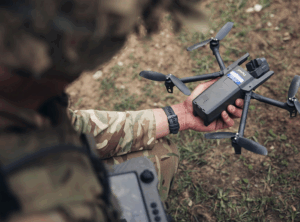Introduction
Like many of us, I love listening to our veterans’ tales, exploits and adventures. They regale stories from their long careers, dits about the changes in warfare and the disruptions following the digital transformation of our armed forces. Suddenly, I feel my age as they talk about some of the equipment I worked on, but in the past tense. As I reflect on this, I think that maybe the military got digital transformation all wrong. Instead of focusing on the transformation of warfare by digitalisation, we have been preoccupied with the digitalisation of the equipment, not on the transformation of our Armed Forces and how we should prosecute a digital war using it. Instead of welcoming AI and digital transformation as a new paradigm for our Armed Services, did we merely apply it as a trendy veneer on legacy ways-of-war models, processes and practices?
In the first major digital war, Ukraine quickly learnt that their legacy Soviet and even adopted legacy NATO doctrine, models, processes and practices, built for the last war, were defunct in this new digital battlespace. As new conflicts arise, this challenges our fundamental assumptions about how we think, work, and measure success in the new AI-enabled profession of arms.
The rise of AI is giving us all a moment of pause. Do we choose to also apply a veneer of AI to the same old legacy processes and practices, making them incrementally a little faster and more efficient … or do we work to focus on the important things in the next war – applying AI to increase our efficiency, effectiveness and lethality? At the same time, we must also chart new skills pathways for all our people and harness everyone’s creativity so we can deliver a truly transformed AI-enabled military. Augmenting and fusing the human mind with advanced AI technologies could provide a pivotal moment for us if we are bold enough to seize it.
Digitalisation isn’t transformation
It has only been a decade since General Barrons presented his vision on Warfare in the Information Age. It promised to revolutionise us for a new way of war. But for many, the outcome was far from revolutionary; instead of truly investing in digital transformation, we faffed and frittered away the opportunity, making only superficial changes and tweaks rather than complete transformation. This approach reinforced and cemented traditional tactics, techniques and procedures from the Cold War era, without dismantling the barriers that separated individuals, tasks and data within our formations. Each team, function and arm got its own ICS, which was meant to enhance efficiency but ended up complicating future efforts to aggregate data and interoperate as one.
While much of our equipment changed, how we operated on the battlefield did not fundamentally change the nature of our work or transform it. We introduced new, better equipment, interfaces, and architectures, improving the speed, security and quantity of the same things we always did. It allowed us to maintain the same old Cold War practices, with the data being passed and workflows remaining disparate, still siloed within different domains.
Instead of transforming how we fight, we extended, prolonged, and gave a lifeline to the old ways of warfare with which we were comfortable. We didn’t challenge the politics or conventions, retire outdated thinking or butcher any sacred cows. How often have we heard “Why do we keep doing it this way?” We failed to change our perspective on how we think. We failed to question whether our traditions were right in this modern battlespace. We failed to understand how we should fight in this digital world. As with digital transformation, there is no one-size-fits-all for AI enablement either, but iteration or refinement of past legacy practices is not the answer.

A reimagined military
A few organisations fundamentally understood the real power of digital; they reimagined their purpose and developed a whole new way of delivering their product/service in the digital era. While many organisations applied modern technology to enhance traditional practices, these digital pioneers redefined and reimagined their models to offer more effective, contemporary and culturally relevant products and services. Examples are Amazon reimagining commerce, Netflix reimagining entertainment, Uber reimagining transportation, Airbnb reimagining hospitality and the Armed Forces of Ukraine reimagining and reshaping C4ISR for the modern AI-enabled battlefield.
The new AI transformation era
The digital era is over; that opportunity has now closed and that epic in our military story has ended. AI is not another new technology but the enabler of a whole new post-digital era of warfare, and it’s putting us to the test once more. This time iteration of legacy will not suffice – reinvention, innovation, and the pursuit of the art of the possible are all encouraged, even assumed by AI. This time, business transformation is the focus and technology (despite the sales pitch from big tech) is secondary; it’s just the enabler. Most of us haven’t stopped long enough to consider whether our present procedures and models are appropriate for this rapidly changing world. This world is metamorphosing in front of our eyes. It’s not just about adjusting to this evolving future; it’s about inventing an entirely new future. But will our siloed traditions and legacy thinking hinder our progress?

AI transformation is different.
The fundamental difference with AI is that it isn’t “digital” – digital is just technology without process improvement. AI fundamentally challenges our preconceived notions about organising, enabling, and prosecuting warfare. AI comes with built-in intelligence and therefore opens an era of innovation, provided it can access relevant, meaningful data and past decisions to train it. It cannot use incomplete, siloed, poor quality or outdated data to optimise insights and knowledge for this new AI future. To create a basis for our future, we must connect all the nodes in this network. In addition to linking data, metadata and silos, it also links people, patterns and work to provide significant results. Our fundamental beliefs about how we operate, think about our profession, and how we define success must be questioned. AI provides the “why,” while digital transformation offers the “how.”
The AI combat arm
Optimising operational efficiency is the goal of every unit, but restricting the benefits of AI to silos is pointless. AI-driven efficiencies will not reach their full potential if they are not connected with all other combat, transport, intelligence, and logistics capabilities, whether regular, reserve, uniformed, or civilian. The Defence Operating Model (updated to the Defence Reform program) explains how this might work, its constituent parts, and how it would integrate with the nation. Although structured in these formations, modern warfare does not operate according to our organisational structures. Since all processes are interrelated, data, knowledge and intelligence must move fluidly across them, the ‘One Defence’ mindset referred to by Caroline Bellamy, the MOD’s Chief Data Officer.

As we contend with evolving infrastructure demands, uncontrolled cloud costs, and heightened security challenges, the ability to make agile, informed technology decisions is more critical than ever. Integrating command intent with multimodal data, regional nuanced behaviours, geopolitical risk analysis and anticipation of needs will elevate decision-making and provide a capability to respond with contextual precision. As seen in recent live-firing drills in Estonia, this is where AI will flourish since it unlocks insights that promote systemic efficiencies.
The delivery of this calls for rethinking how we function and rewiring the ecosystem, not merely the deployment of ‘cool tech’. We must therefore embrace operational innovation and rethink roles, processes, and collaborations with an AI-first lens, rather than simply up-teching current capabilities. We must transform from siloed ICS capabilities to a holistic, intelligence-based, lethal war-fighting machine – a new AI-enabled digital combat arm to achieve exponential gains and future relevance. This unlocks new synergies, competencies in our people and future-ready capabilities that deliver competitive advantages and strategic leverage in a modern war. Designing a connected multi-dimensional, multi-domain (MDDO) military force where AI supports a new way of working, a new way of war that is exponentially faster, more flexible, and more able to drive strategic effects at all levels, domains and dimensions will be a big challenge.
AI-Era mindset
FOMO cannot be our strategy; instead, a radical change in perspective will be necessary for this degree of corporate transformation. The first step in this AI-enabled transformation will be to connect all the workflows from all nodes. These segregated workflows were never intended to communicate throughout Defence, so we must jumper across them. To unite all, the role of our Armed Forces might need to be reimagined and rewired. Innovation, ideas, people, and data must be linked and activated like never before. We can no longer limit ourselves to enhancing legacy doctrine or operational models; they will not work in the AI era. We must reimagine these models, processes, and workflows to prosecute warfare in the post-digital multimodal AI era.
When we undergo this genuine organisational transformation, everything – people, equipment, and data- becomes connected. This is when the power of AI comes to life, supercharging how we work and unlocking new activities, performance levels and deliverables we didn’t think were possible. Similar to the promises of the digital era, AI organisations are now starting to form. Increasingly over the coming days, weeks and months, these organisations will become the new Amazon, Netflix, Uber and Airbnb of the AI era. Will we ‘Uberise’ British Armed Forces for this War in the SmartPhone Age?
Post-digital warfare
As we reimagine warfare in a post-digital era, we must develop a holistic AI ecosystem that connects, optimises, and augments how we fight and prosecute warfare. We must envision a world where integrated workflows connect functional and cross-functional teams seamlessly, enhancing collaboration among people, roles and data. We are on the brink of witnessing Large Language Models (LLMs) transition into smaller bespoke multimodal models and action models, which will forge a unified system of insights and actions for our warfighting environment. We have been using Predictive AI for years and have recently played with Generative AI. Still, now we are starting to field Agentic AI digital co-workers, next will be Artificial General Intelligence (AGI) and then full autonomy. Are we prepared for this?
AI is not merely a tool for automation; it expands our potential, enabling us to accomplish tasks that were once beyond reach. AI agents (Agentic AI) will expedite the connection of various workflows across Defence as AI becomes increasingly embedded within our formations. These agents will learn to act on our behalf, driving operational transformation in augmented, agent-driven, and exponentially impactful ways – ushering in this new era unlike anything we have experienced before. This promises new heights of performance, output, and effectiveness, but it will reshape the traditional patterns we once knew, empowering us to expand in previously unattainable ways.
Conclusion – this is the AI era
We are on the brink of developing exponentially more powerful Armed Forces, all thanks to these cohesive, intelligent platforms, the new operating system for a reimagined AI-driven organisation. For the first time since the development of the Internet, we have the opportunity to not only establish a whole new way of working but also innovate an intelligent military that delivers a step change in Defence capabilities.
In this AI era, digital transformation has morphed into AI-driven organisational transformation. AI is already becoming an integral reality in which augmented intelligent decision-making is designed responsibly, and ethically built, and is quickly becoming essential for military operations. AI agents will create new opportunities for us to learn, optimise, and enhance our work, capabilities, and potential. In an increasingly complex, hybrid, multi-cloud and AI-fuelled environment, this will compound exponentially every year from now on.
In collaboration with AI, we can envision the characteristics of an integrated, augmented and lethal Armed Forces wherever curiosity exists, and exploration ensues. We need to confidently ask questions if we don’t know (don’t just nod to mask ignorance), employ scepticism with everything we are told, and make sure we understand the implications of what is being described. We will play, explore and experiment in safe spaces so that new frontiers, innovation and transformation can become inevitable outcomes.
The upcoming decade is projected to be the most productive in human history, where speed matters and rapid technological adoption led by tech-savvy individuals will be critical to operational success. What a remarkable opportunity it now presents to ambitious leaders amongst our ranks, a once-in-a-career opportunity to write a whole new chapter into our history; a whole new set of tales, daring exploits, dits and adventures to regale future generations.
(Main picture from Kefron)

Martin Crilly
Martin Crilly is the Chief Architect & Engineering Authority to BAE Systems in the Middle East, and a Reserve Signals Officer. His background is in contempary ICT architecture, technology strategy, cyber-security, J2 and J6 with previous roles in BFC, ISS Ops Plans, GOSCC, DE&S Maritime and others. For more information and articles on Virtual War and similar topics, ‘follow’ him on Defence Connect.





